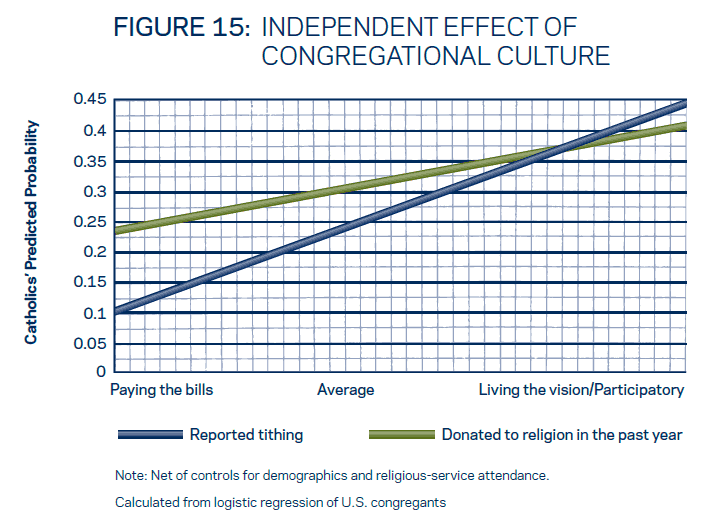A Look at Stewardship: a New Study from Notre Dame
July 9, 2014

Among pastors’ sources of stress, little comes close to financial concerns. This is what keeps pastors—even the most skilled—up at night. Running a large physical plant and compensating staff requires a substantial budget, and Catholics (generally speaking) are not known for their generous giving. In recent study Unleashing Catholic Generosity, Brian Starks and Christian Smith (both of Notre Dame) set out to answer the golden-ticket question, “What is holding American Catholics back from greater financial generosity?”
In an earlier (2008) study, Passing the Plate: Why American Christians Don’t Give Away More Money, Christian Smith, Michael Emerson, and Patricia Snell identified two different models for how congregations discuss money: 1) “paying the bills,” and 2) “living the vision.” A culture of “paying the bills” focuses on need and scarcity; money and spirituality are addressed as separate matters. In contrast, congregational cultures that “live the vision” communicate with their parishioners about the strong connection between finances and investment in Christian mission.
To see how parish culture impacts generosity and giving, Starks and Smith compared Catholic and non-Catholic churches with both of these “congregational cultures”. They found that the “assumptions, beliefs, and meanings” of parishioners’ social environments do shape giving behavior (4). Those who understand property and wealth to belong to God (rather than the individual) and those who experience increased empathy and compassion for others are more likely to give generously, Starks and Smith concluded. At the parish level, then, efforts to challenge materialism and promote empathy and compassion—both clearly part of a Christian vision—can also be strategies to encourage generous giving.
In short, parish cultures that focus on “living the vision” have parishioners who report higher levels of giving. For example, of the parishioners who strongly agreed with the statement “I personally feel part of the planning of the vision and the mission of my religious congregation,” 69.6% reported religious tithing, compared to only 19.3% of people who strongly disagreed with the statement (21). This is indicative of the broader trend depicted below, which shows that “living the vision” parishes have parishioners who report higher levels of both tithing and religious donations (Starks and Smith, 23).
These findings are consistent with our own on stewardship. Our dataset consists of pastors at vibrant, thriving parishes—parishes where, in many cases, financial health is quite good. When these pastors spoke about stewardship and giving, they discussed the “spirituality of stewardship.” As a pastor in Colorado said, “So many people hear the word ‘stewardship’, and they think it’s money. It’s far more than money. It’s really a way of life. It’s about evangelization… adopting a spirituality of stewardship really leads to a changed attitude in how people live their daily life…taking what they believe and putting it into action.” Similarly, a Washington pastor explained, “If we’re going to raise significant funds for something, you know, we’ve got to do it in a way that raises faith.” At Old St. Pat’s in Chicago, they’ve taken this message to heart: In reference to their most recent capital campaign, launched earlier this year, Fr. Tom Hurley identified some priorities others would expect of a historic church: renovation of the rectory and the establishment of a preservation fund. (Old St. Pat’s was built in 1856 and is now the oldest public building in Chicago.) Their third priority, however, is the “Kinship Mission”: Old St. Pat’s will bring seed money to the renovation of a property to create student housing for homeless teenagers on the West Side of Chicago. As parishioners contribute to the capital campaign, they’re not only “paying the bills” at Old St. Pat’s, but they will also be contributing to a “social outreach expression of our mission,” as Fr. Tom Hurley puts it.
Ultimately, in these vibrant parishes of our dataset as well as in Starks and Smith’s research, parishioners link their financial giving to their own discipleship—it is part of their participation in the mission. When the parish culture emphasizes living the vision—a vision that includes empathy toward others and attachment to God—generosity flows.
SOURCES:
Smith, Christian, Michael O. Emerson, and Patricia Snell. 2008. Passing the Plate: Why American Christians Don’t Give Away More Money. New York: Oxford University Press.
Starks, Brian, and Christian Smith. “Unleashing Catholic Generosity.” Catholic Social and Pastoral Research Initiative. <http://icl.nd.edu/initiatives-projects/catholic-social-and-pastoral-research-initiative/cspri-research/>






